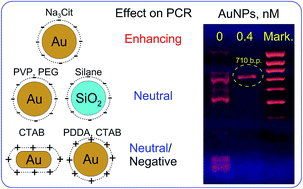Gold nanoparticle-assisted polymerase chain reaction: effects of surface ligands, nanoparticle shape and material†
Abstract
Recent reports have shown significant improvement of the polymerase chain reaction (PCR) efficiency and specificity with the addition of gold nanoparticles (AuNPs). However, the underlying mechanisms are still unclear and debatable. Here, we report effects of AuNP concentration, shape, material, and surface functionalization on PCR outcome under typical amplification conditions. All nanoparticles were tested with two PCR diagnostic models: (1) the nitrogen fixation (NifD) gene from Azospirillum brasilense Sp7 bacteria and (2) the polymorphic ompA gene encoding major outer membrane protein of Chlamydia trachomatis. The optimal concentration of 16 nm citrate-stabilized negatively charged spherical AuNPs (zeta potential −29.9 mV) was determined to be 0.4 nM, in agreement with previous data for quite different PCR systems. Functionalization with poly(vinylpyrrolidone) (PVP) and thiolated PEG (mPEG-SH) essentially did not change the zeta-potential (−30 mV and −21 mV, respectively), but completely suppressed the PCR enhancement. Positively charged AuNPs with poly(diallyldimethylammonium) (PDDA) and cetyltrimethylammonium bromide (CTAB) capping polymers exhibited no specific enhancing effect on PCR or even inhibited the reaction at 5 pM of AuNP–PDDA. Also, no specific PCR enhancement was obtained with CTAB-stabilized gold nanorods. To elucidate the role of the particle material, we performed PCR with gold and silica particles of comparable size and equal negative charges. In contrast to the great PCR enhancement with 16 nm AuNPs, 20 nm silica nanoparticles did not affect the PCR efficiency or inhibit the reaction at concentrations higher than 100 nM. These findings suggest that the nature of the PCR system components, surface stabilizing agents and the thermal conductivity of the nanoparticle material can play important roles in the nanoparticle-mediated PCR.



 Please wait while we load your content...
Please wait while we load your content...